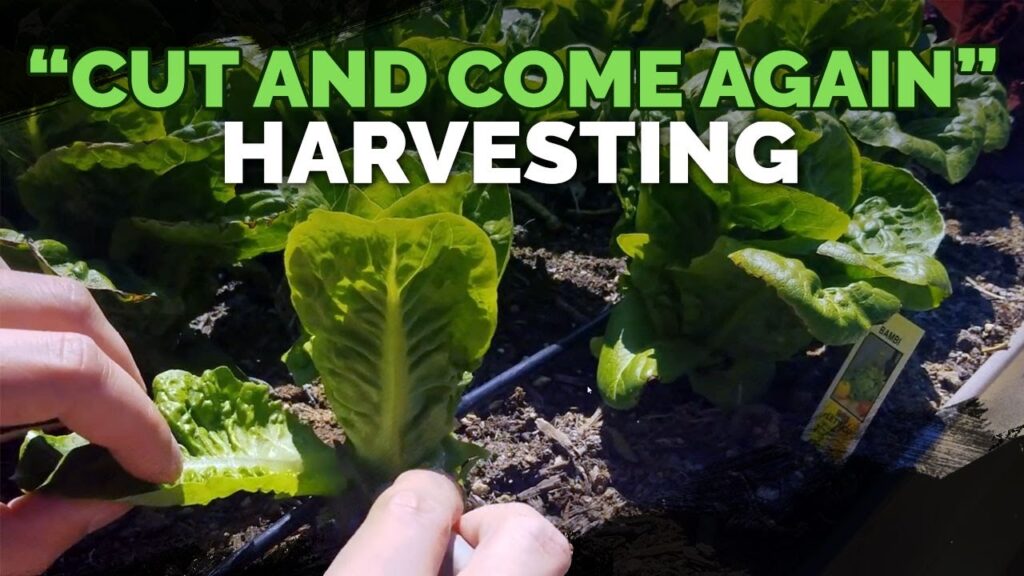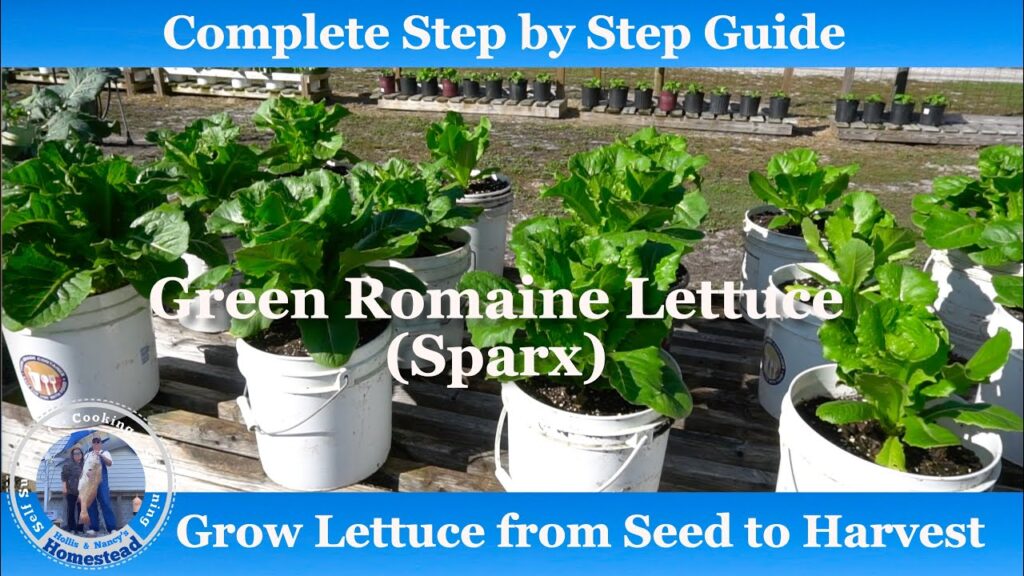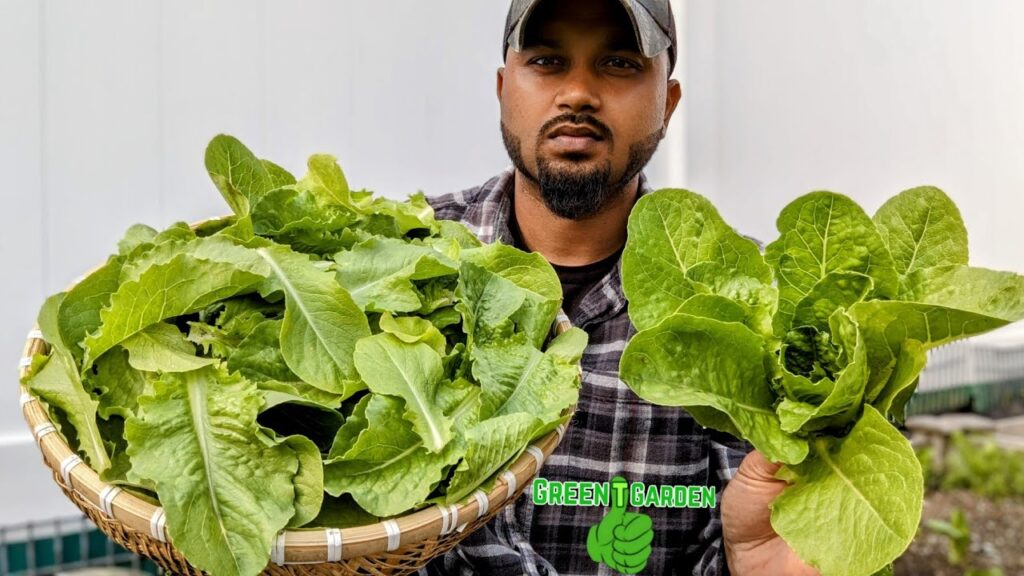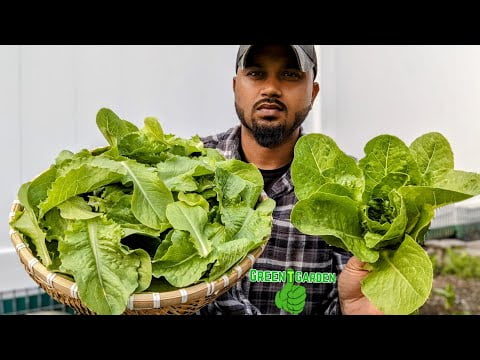In this informative article, you will find a step-by-step guide to harvesting romaine lettuce through an engaging video. This video will walk you through the entire process, providing valuable tips and techniques to ensure a successful harvest. Whether you’re a seasoned gardener or just starting out, this guide is a must-watch for anyone looking to grow and harvest their own fresh romaine lettuce. So grab your gardening gloves and get ready to learn all about the art of harvesting romaine lettuce.

Preparing for Harvesting
Before you start harvesting your romaine lettuce, there are a few important steps you need to take to ensure a successful and rewarding harvest.
Selecting the Right Time
The first step in preparing for harvesting your romaine lettuce is to choose the right time for harvesting. Romaine lettuce is typically ready for harvest when the heads are firm and fully developed. The outer leaves should be dark green and crisp while the inner leaves remain tightly packed. Make sure to avoid harvesting the lettuce too early when the heads are still small or too late when they begin to bolt or turn bitter.
Gathering the Necessary Tools
Next, gather all the necessary tools for harvesting your romaine lettuce. A sharp knife or pair of garden shears will be required for both cutting and whole head removal methods. Additionally, it’s a good idea to have a bowl or bucket for rinsing the harvested lettuce and a salad spinner or paper towels for drying the leaves. Having these tools ready beforehand will make the harvesting process smoother and more efficient.
Inspecting the Romaine Lettuce
Before you start harvesting, it’s important to inspect the romaine lettuce plants for any signs of disease or pests. Look for any discoloration, wilting, or damage on the leaves, as these can indicate potential issues. It’s also advisable to remove any outer leaves that are damaged or discolored before harvesting. By inspecting the lettuce beforehand, you can ensure that you harvest only the healthiest and freshest leaves.
Harvesting Techniques
There are two main harvesting techniques you can use for romaine lettuce: the cutting method and the whole head removal method. Each method has its own advantages and it’s up to you to choose the one that suits your needs and preferences.
The Cutting Method
The cutting method involves harvesting mature leaves one at a time, allowing the plant to continue growing and producing more leaves. This method is great if you want a continuous supply of fresh lettuce throughout the season.
The Whole Head Removal Method
The whole head removal method, as the name suggests, involves removing the entire head of lettuce at once. This method is ideal if you want to harvest a larger quantity of lettuce at once, such as for a salad or a meal.

Cutting Method
Locating Mature Leaves
To use the cutting method, start by locating the mature leaves on your romaine lettuce plant. These are usually the outer leaves that are fully developed and have a darker green color. The inner leaves will continue to grow and develop, so it’s important to leave them intact.
Using a Sharp Knife
Once you’ve identified the mature leaves, carefully use a sharp knife or garden shears to cut them off at the base of the plant. Make sure your knife is clean and sharp to ensure a clean cut and avoid damaging the leaves or the rest of the plant.
Making a Clean Cut
When cutting the leaves, aim to make a clean cut at the base of the plant, just above the soil level. Avoid tearing or ripping the leaves, as this can lead to damage and affect the quality of the harvested lettuce. By making a clean cut, you ensure the plant will continue to grow and produce new leaves.
Avoiding Damage to Surrounding Leaves
As you harvest the mature leaves, be careful not to damage or disturb the surrounding leaves. Take your time and focus on each leaf individually, ensuring that you don’t accidentally cut or break any of the neighboring leaves. This will help maintain the overall health of the plant and allow it to continue growing.
Whole Head Removal Method
Evaluating the Whole Head
If you choose to use the whole head removal method, start by evaluating the romaine lettuce head to ensure it’s ready for harvest. Look for a tight and compact head with fully developed leaves. Avoid harvesting heads that are small or have loose leaves, as these are signs that the lettuce is not yet mature enough for harvest.
Grasping the Base of the Plant
To harvest the entire head of romaine lettuce, firmly grasp the base of the plant with one hand. Hold the plant just above the soil level, ensuring that you have a secure grip to avoid damaging the leaves or accidentally uprooting the entire plant.
Gently Twisting and Pulling
With a firm grip on the base of the plant, gently twist and pull the romaine lettuce head upwards. Apply gentle and steady pressure to encourage the head to detach from the roots. Avoid using excessive force, as this can damage the lettuce or disturb the surrounding soil.
Ensuring Complete Removal
Once you have successfully pulled out the romaine lettuce head, make sure to inspect the base of the plant. Ensure that the head was completely detached from the roots and that no portion of the root system remains attached. By ensuring complete removal, you help the plant rejuvenate and continue producing new heads.

Post-Harvesting Steps
After you’ve harvested your romaine lettuce, there are a few important steps you should take to ensure the freshness and quality of your harvest.
Rinsing the Harvested Lettuce
The first post-harvesting step is to rinse the harvested romaine lettuce. Fill a bowl or bucket with cold water and carefully place the lettuce leaves into it. Gently swish the leaves in the water to remove any dirt or debris that may be clinging to them.
Drying the Leaves
Once the lettuce leaves are clean, it’s essential to dry them thoroughly to prevent wilting and spoilage. There are a few methods you can use to dry the leaves effectively.
Using a Salad Spinner
One option is to use a salad spinner. Place the rinsed lettuce leaves in the salad spinner and give it a few spins to remove excess water. The centrifugal force will help dry the leaves quickly and efficiently.
Patting with Paper Towels
If you don’t have a salad spinner, you can pat the lettuce leaves dry with paper towels. Lay out a clean kitchen towel or a few layers of paper towels on a flat surface. Gently place the rinsed leaves onto the towels and pat them dry, being careful not to crush or damage the leaves.
Avoiding Excessive Pressure
Whether you’re using a salad spinner or paper towels, it’s important to avoid applying excessive pressure when drying the leaves. Be gentle and take your time to ensure that the lettuce leaves don’t become bruised or torn in the process.
Storing the Romaine Lettuce
Proper storage is crucial to maintain the freshness and quality of your harvested romaine lettuce. Follow these steps to ensure your lettuce stays fresh for as long as possible.
Refrigerator Storage
After rinsing and drying the lettuce leaves, transfer them to a refrigerator-safe container. A plastic or glass container with a tight-fitting lid works best for keeping the leaves fresh and protecting them from moisture and odors in the refrigerator.
Plastic Bag Method
An alternative storage method is to place the rinsed and dried lettuce leaves in a plastic bag. Squeeze out any excess air from the bag before sealing it to create a relatively airtight environment. However, be cautious not to pack the bag too tightly, as this can crush the leaves.
Avoiding Moisture Buildup
Regardless of the storage method you choose, it’s crucial to avoid moisture buildup. Moisture can lead to wilting and spoilage of the lettuce. To prevent this, make sure the lettuce leaves are completely dry before storing them, and regularly check the container or bag for any signs of moisture accumulation.
Proper Temperature and Humidity
Lastly, store the romaine lettuce in the vegetable compartment of your refrigerator. The ideal temperature for romaine lettuce is around 32°F to 36°F (0°C to 2°C), with a relative humidity of 95%. It’s essential to maintain these conditions to ensure the lettuce stays crisp and fresh for an extended period.
Troubleshooting Tips
While harvesting romaine lettuce can be a rewarding experience, it’s not without its challenges. Here are some troubleshooting tips to help address common issues that may arise.
Dealing with Pests
Pests can pose a significant threat to your romaine lettuce plants. Keep an eye out for common pests such as aphids, slugs, and snails. If you notice any signs of pest infestation, promptly take measures to control and eliminate them. This can include using organic pest control methods or seeking advice from local gardening experts.
Addressing Diseases
Like any plant, romaine lettuce is susceptible to diseases. Common diseases include lettuce rot, powdery mildew, and downy mildew. To address these diseases, it’s important to promptly remove and destroy any infected plants or leaves. Additionally, practicing proper crop rotation and providing adequate air circulation can help prevent the spread of diseases.
Identifying Nutrient Deficiencies
Sometimes, your romaine lettuce plants may show signs of nutrient deficiencies. Common deficiencies include nitrogen, phosphorus, and potassium. Look for symptoms such as yellowing leaves, stunted growth, or poor overall plant health. Identifying the specific deficiency can help you adjust your fertilizer application or soil amendments to provide the necessary nutrients.

Addressing Diseases
When it comes to addressing diseases in romaine lettuce, understanding common diseases, their preventive measures, and treatment options is crucial for a successful harvest.
Common Diseases on Romaine Lettuce
Some common diseases that can affect romaine lettuce include lettuce rot, powdery mildew, downy mildew, and bacterial leaf spot. Each disease has its own set of symptoms and can cause significant damage if left untreated.
Preventive Measures
Prevention is key when it comes to managing diseases in romaine lettuce. To minimize the risk of disease, ensure that you have healthy and disease-resistant varieties of romaine lettuce. Practice proper sanitation in your garden by cleaning up plant debris and removing any infected or diseased plants promptly. Additionally, providing adequate air circulation and avoiding overwatering can help create an environment less conducive to disease development.
Treatment Options
If despite preventive measures, you notice signs of disease in your romaine lettuce plants, there are several treatment options available. Organic fungicides and bactericides can be used to control fungal and bacterial diseases. However, it’s important to carefully follow the instructions and use these products sparingly. In severe cases, it may be necessary to remove and destroy infected plants to prevent further spread of the disease.
Harvesting romaine lettuce can be a rewarding experience, especially when you follow the proper techniques and take post-harvesting steps to maintain the freshness and quality of your harvest. By selecting the right time, gathering the necessary tools, and using the appropriate harvesting methods, you’ll be able to enjoy crisp and delicious romaine lettuce straight from your garden. Remember to pay attention to pest and disease management to ensure your plants stay healthy and productive. With the right knowledge and a little care, you’ll be able to enjoy a bountiful harvest of romaine lettuce throughout the season.



